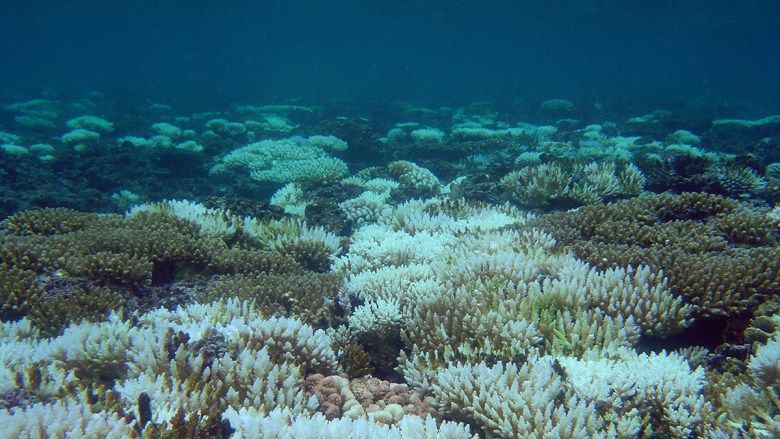
In 2023, a marine heat wave gripped the oceans, and coral reefs around the world bleached, turning ghostly white. NOAA estimates that since 1 January 2023, more than 72% of reef area worldwide could have been affected.
When stressed, corals bleach—they expel the symbiotic algae that lend them their vibrant colors and their main source of food. Reefs can sometimes recover from bleaching. But sufficiently long, extreme, or frequent heat waves can kill. In the Florida Keys, where NOAA is investing nearly $100 million in coral restoration, record-breaking temperatures killed more than one third of planted staghorn corals and up to 95% of planted elkhorn corals.
Bleaching typically begins in late summer, when water temperatures peak. But as oceans warm, many reefs could begin to bleach in spring by 2080, according to a new study. Along the equator, some reefs may be at high risk of bleaching year-round.
Warming seas threaten reefs worldwide, but scientists are still working to understand when and where bleaching will be most severe.
On the basis of two different climate projections, a group of scientists assessed bleaching risk around the world. The analysis, published in a paper in Science Advances, compared a future scenario with high greenhouse gas emissions (Shared Socioeconomic Pathway (SSP) 5-8.5) to a medium-emissions scenario (SSP2-4.5) that reflects the world as it would be if countries stick to their existing pledges to limit emissions.
“It’s important for us to predict how different reef sites across the globe will fare.”
“It’s important for us to predict how different reef sites across the globe will fare,” said coral reef ecologist Miguel Mies of the University of São Paulo in Brazil. “It’s very difficult to predict,” he added, because heat stress is just one of many relevant factors. “But for their metric, they did a really good job.”
The researchers divided a map of the world’s reefs into tens of thousands of square pixels, each about 50 kilometers on a side. Then, using the Coupled Model Intercomparison Project Phase 6 (CMIP6) projections for day-to-day sea surface temperature, they assessed multiple factors associated with bleaching risk, including the severity, duration, and timing of heat stress.
“The innovation of our paper is that we didn’t just look at how severe it will be, but also how long it would last during the year,” said quantitative biologist Camille Mellin of the University of Adelaide.
Mellin and her colleagues tuned their model by comparing its predictions to real records of sea surface temperature and coral bleaching from 1985 to 2014, then tested the two different climate scenarios for the future. The calculation took some serious computational heft—the team needed a supercomputer to get the job done.
Comparing the two emissions scenarios revealed regions where cutting greenhouse gas emissions could benefit reefs most. Coastal Venezuela and Colombia, for instance, are expected to experience lower bleaching risk than the rest of the Caribbean thanks to upwellings of cool, deep water. But in some large regions, especially those right along the equator, reducing emissions didn’t reduce bleaching much.
Some regions, including parts of the Pacific Coral Triangle and Micronesia, as well as waters off the Pacific coasts of Panama, Colombia, and Ecuador, will begin bleaching in spring instead of summer even in the medium-emissions scenario. In the high-emissions scenario reefs off Hawaii’s coasts would begin bleaching in spring, too. By 2080, reefs in the most vulnerable spots along the equator, such as the eastern Coral Triangle, the Marshall Islands, and central Polynesia, could bleach year-round.
Nothing Left to Save
Even that grim projection could be “almost misleading,” said Maria Beger of the University of Leeds, who was not involved in the work. “The reefs don’t have time, you know, reefs are being degraded now, reefs are dying now.” By some estimates, more than half of the reefs alive in 1950 have already died. “In 2080—we don’t care, nothing will be left if nothing happens now,” she said.
“We’ve lost 55% of what we had. And we still losing a lot.”
Tom Goreau, the president of the Global Coral Reef Alliance, likewise stressed the urgency of reducing emissions and protecting reefs now. Generations of his family have documented reefs for almost a century. “What we’ve learned is they’re disappearing much faster than anyone who makes models can realize.”
James Guest, a coral reef ecologist at Newcastle University who was not involved in the study, pointed out that this study doesn’t account for corals’ ability to adapt to changing conditions—a limitation the study authors acknowledged. For now, there just weren’t enough data to include adaptation in the model, Mellin said. “Future research should really focus on that.”
“We’ve lost 55% of what we had. And we still losing a lot,” Mies said. Adaptation won’t change that, he said—most reefs will not be able to cope with how fast the climate is changing. “But some, a small portion of that, will adapt. And that’s what’s going to survive.”
—Elise Cutts (@elisecutts), Science Writer
Citation: Cutts, E. (2024), Some reefs could bleach year-round by 2080, Eos, 105, https://doi.org/10.1029/2024EO240354. Published on [DAY MONTH] 2024.
Text © 2024. The authors. CC BY-NC-ND 3.0Except where otherwise noted, images are subject to copyright. Any reuse without express permission from the copyright owner is prohibited.
Related
